California Condor Profile
Scavengers get a bad rap. They’re considered stupid, dirty animals that occupy a lower tier in animal society than the more reputable hunters and graceful herbivores.
California condors both contradict and reinforce this stereotype in many ways, being both huge and graceful, but also routinely covered in pee and prone to fear puking.
Sadly they became extinct in the wild in 1987, but have since been subject to intensive captive breeding programs and reintroduced to California and Arizona. It’s estimated there is now over 500 individuals living in the wild today, making them one of the rarest bird species in the world.

California Condor Facts Overview
| Habitat: | Rocky shrubland, coniferous forest, and oak savanna |
| Location: | Mexico, USA |
| Lifespan: | Up to 70 years |
| Size: | Around 3-meter (9ft) wingspan |
| Weight: | Up to 11kg (24lb) |
| Color: | Black with bands of white under the wings |
| Diet: | Mammal carcasses |
| Predators: | Humans, golden eagles, bears |
| Top Speed: | 65 kph (40 mph) |
| No. of Species: |
1 |
| Conservation Status: |
Critically Endangered |
The California condor is a New World vulture and the largest land bird in North America. They live in rocky shrubland and forests near cliffs or large trees for nesting.
Condor is a common name for two species, including the close relative of the California condor, the Andean condor (Vultur gryphus), which inhabits the Andean mountains in South America.
California condors are simple animals. They aren’t good at much, but they know what they’re good at. Their enormous wingspan carries them hundreds of miles on high-altitude foraging trips, picking out mammal carcasses with keen eyesight to bring back to their ugly little babies.
Despite being a bit rubbish, these are impressive birds, with a sad history of direct persecution, and a plight from second-hand bullets that continues to threaten the species with extinction.
Interesting California Condor Facts
1. They are the largest bird in North America
The California condor has a 3m wingspan (9.8ft) and weighs up to 12kg (26 lb), which makes it the largest bird in North America.
The female California condor is smaller than the male, which is unusual among birds of prey.
The average weight and wingspan of this condor beat pretty much every other flying animal, making it, generally, the largest flying creature in existence, on average.
Although, they don’t quite make the top spot for largest wingspan in the world. Check out our largest flying birds in the world piece for more.
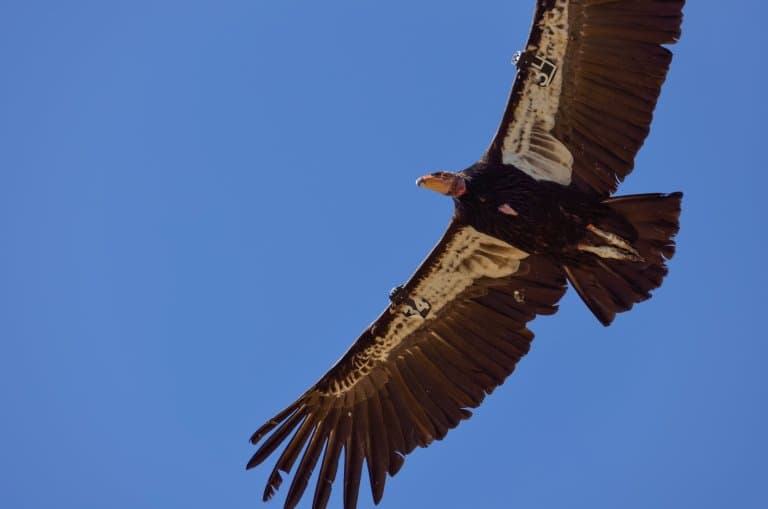
2. Born on High
California condors spend much of their lives at high elevations. Nesting sites are commonly between 460 meters and 1,300 meters above sea level, but they’re also found more than 2,000 meters up, usually making use of natural holes in cliff faces or exceptionally tall trees.
These huge birds show a huge range of nesting sites and designs. Nests as small as 43cm across are commonly found near those as spacious as 3.7 meters across! They build a gravel or silt floor for the nesting space, upon which the eggs are laid and protected. 1
3. They’re not very good at building their nests
Other than the gravel floor, they don’t seem to put a lot of work into nest building. They’re not super fussy about the conditions, either. Nests can be deep, shallow, hidden, or exposed, and eggs are commonly kept both in total darkness and in direct sunlight.
Many nests are easily accessed by terrestrial predators, which accounts for a high rate of failure in the condor’s reproduction.
The strange thing is that these bad nesting practices don’t appear to be a result of a lack of good real estate. Breeding site choice for these birds is still a matter of study, as it relates strongly to their success as a species.
Parents will change nest sites each breeding season, whether the breeding was a success or a failure.
4. They’re slow to grow
Despite being born with its eyes open, it can take a condor chick a week to drag itself out of the egg. When hatched, they’re ugly little fluff balls with bald faces and necks.
Both parents will guard the chick, and since there’s only one, they do seem to pay close attention to it. This is a resource-intensive breeding strategy; parents will alternate foraging trips of over 250km (160 miles) to find food for the chick’s growth.
The chick will stay in the nest for five to six months, and remain dependent on its parents for up to a year. By six years, the condors are ready to start breeding. 2
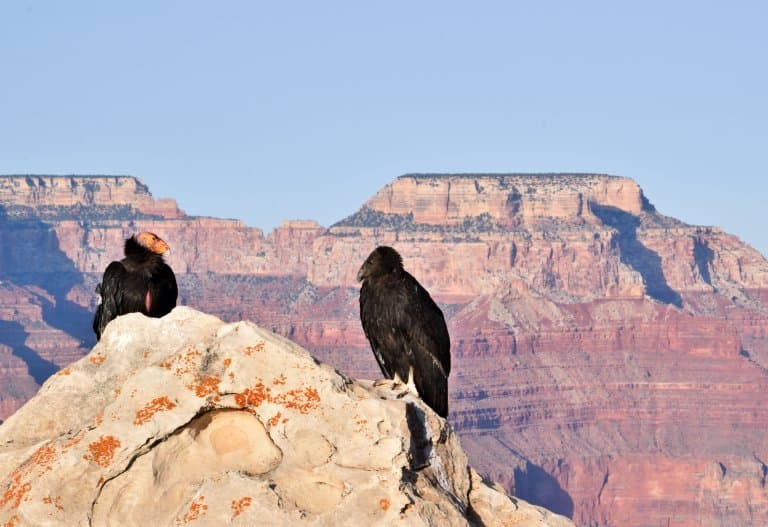
5. They have blunt talons
There are a few other things that make this animal a strangely simple beast. Not only are they a bit crap at breeding, but they also have very limited physical characteristics too.
Since they spend a lot of time perched or walking on gravel and rocks, their talons are blunt. Their rear nail is only slightly curved and not good for gripping.
While this would be a handicap for an eagle, these condors prefer to scavenge meat from carcasses rather than catch it themselves, so they get by with talons that most raptors would scoff at. 3
6. They can barely talk
They’re not even good at communicating. Most birds have a syrinx, which is the bird-like equivalent of a larynx. This is what allows for the diverse and intricate vocal communication we see within other bird communities.
Condors have no such thing. They hop around grunting and hissing at one another, instead. But this primitive communication style is enough to maintain a hierarchical social set-up.
These are basic birds with basic needs, and this has served them well. While they’re not good at much, there are some things that set them apart from other birds. 4
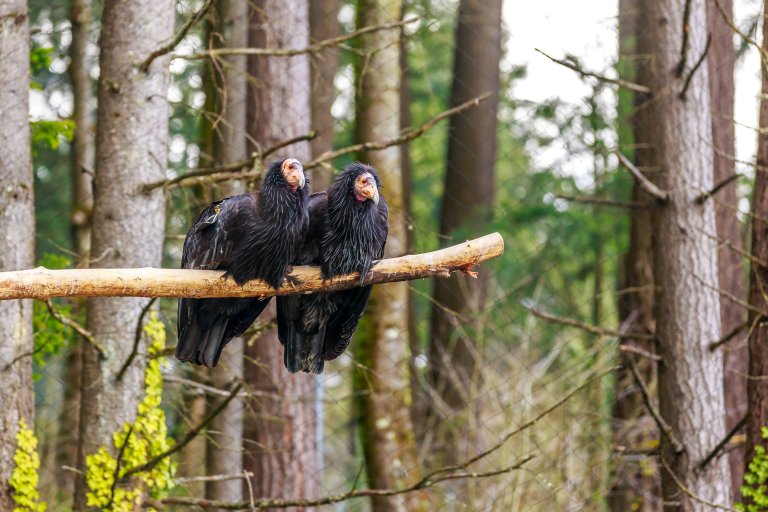
7. They pee on themselves when they get too hot
This is a bold but effective statement in any community, but in birds, it’s usually impossible.
In most species, birds aren’t capable of peeing. Instead, it’s common for all waste products to emerge from the same passage.
A typical bird poo contains ureic waste as well as faecal waste, all delightfully mingled by the time it leaves the cloaca. But not in California condors! They can separate their excretions.
When they’re feeling warm, California condors excrete a refreshing stream of cooling pee onto their legs. The water in this cocktail evaporates, drawing heat away from the bird, just like sweat does on more civilised animals.
It also leaves behind solid waste, which in the condor is a wide powdery substance called uric acid, which gives them a nice white sheen on their legs.
8. Fear Puking
But that’s not the end of it. If you weren’t put off enough by the crusty piss legs, they have another trick up their sleeves.
When agitated and afraid, California condors vomit up rancid carcass juice and partially-digested meat.
It’s commonly thought to be a defence mechanism, but the local National Parks Service says this is just a sign of nervousness and isn’t primarily a defensive strategy.
Vomiting serves two obvious potential purposes, though: first, it makes the bird lighter, so they might be able to escape quickly. Secondly, it’s disgusting.
Quite a few bird species weaponise vomit, so it’s not far-fetched to believe that the Condor can at least benefit from the reputation, even if it’s not doing it on purpose.
9. Their bald head helps them when feeding
This is an adaptation that helps them stay cleaner when putting their heads inside carrion and stops blood from matting and clogging up any feathers.
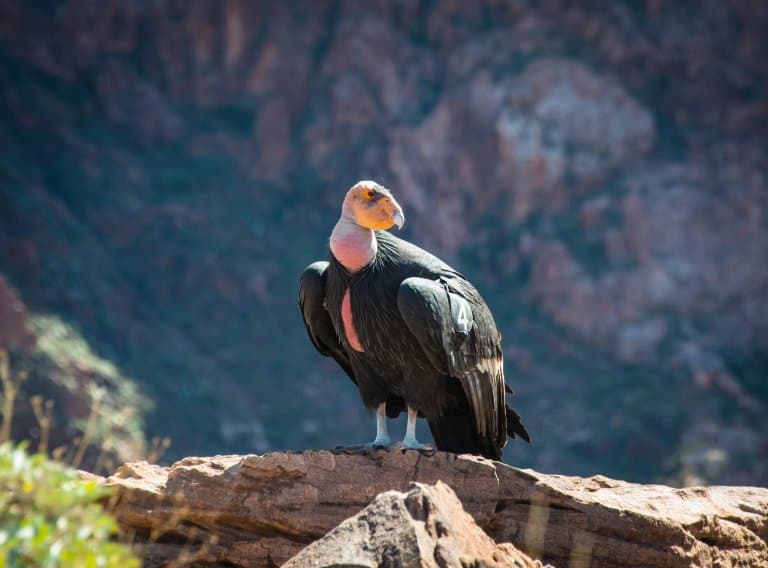
10. Condors are the longest living bird species
Many birds are known for their longevity, with some species regularly exceeding 30 or 40 years of age. Condors, however, may be the longest-lived birds in the world.
A male named Thaao, born in captivity in 1930, lived to an impressive 79 years of age- the longest recorded lifespan for any bird. 5
11. They’re in danger from lead
While conservation efforts have led to protections against hunting these birds, they’re still suffering indirectly from bullets.
Condor stomach acids are extremely powerful, allowing them to digest small bones and ensuring that any harmful bacteria in their food are annihilated before they can do any damage.
However, this makes condors particularly prone to lead poisoning because, unlike other scavengers, their digestive system can actually break down bullets that are often left in carcasses killed by hunters.
Lead shot from the meat they scavenge is poisoning condors, and is a slow and unpleasant way to die. This problem is so prevalent that protected populations are routinely checked for lead and given medicines to help reduce the build-up in their systems.
While wild populations of the California condor are still exceptionally rare and critically endangered, their numbers are on the rise, and captive hatchings are doing well.
If the issue of lead poisoning can be addressed, it’s only a matter of time and education before they can be reintroduced. 6
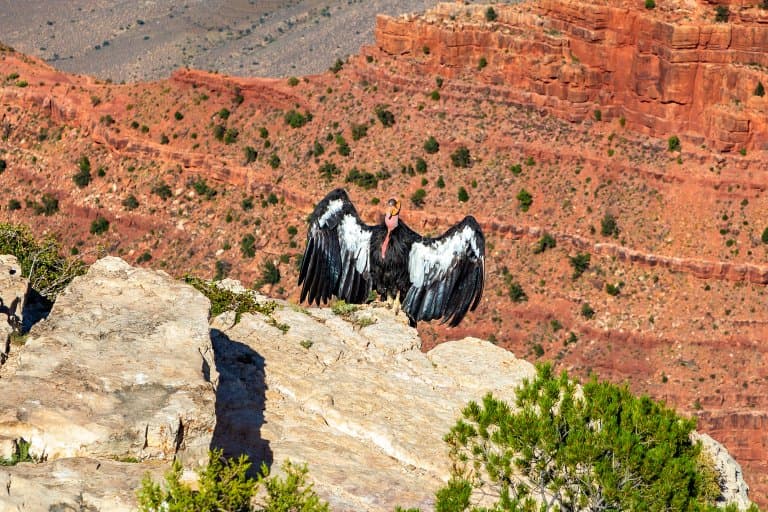
12. Conservation efforts are providing hope for California condors
At one point in time, the California condor was completely extinct in the wild – when their situation was looking particularly dire in 1987. 22 remaining wild individuals were captured and placed into a breeding program led by the San Diego Wild Animal Park and Los Angeles Zoo.
The California condor conservation project is one of the most expensive in US history, costing over $35m in total with an annual cost of $2m a year.
There are now over 500 adult California condors in the wild, and intensive conservation efforts are ensuring that their numbers are steadily increasing. 7
California Condor Fact-File Summary
Scientific Classification
| Kingdom: | Animalia |
| Phylum: | Chordata |
| Class: | Aves |
| Order: | Accipitriformes |
| Family: | Cathartidae |
| Genus: | Gymnogyps |
| Species Name: |
Gymnogyps Californianus |
Fact Sources & References
- Snyder, N. F. R., Ramey, R. R., & Sibley, F. C. (1986), “Nest-Site Biology of the California Condor“, The Condor.
- “California Condor (Gymnogyps californianus) Fact Sheet: Reproduction & Development“, San Diego Zoo.
- James Orton (1871), “On the condors and humming-birds of the Equatorial Andes“, Annals and Magazine of Natural History.
- Radhika Roach & Malisha Vinod Patel (2019), “CALIFORNIA CONDOR: A Literature Synthesis of Primary Threats and Population Recovery Efforts“, Research Gate.
- Wood, Gerald L (2012), “The Guinness book of animal facts and feats“, Internet Archive.
- Alyssa Kapnik (2019), “Program To Save The California Condor From Extinction Is Making Strides“, KALW.
- BirdLife International (2020), “Gymnogyps californianus“, The IUCN Red List of Threatened Species 2020.
